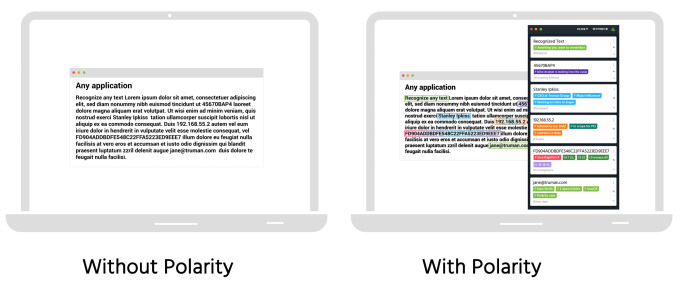Polarity raises $8.1M for its AI software that constantly analyzes employee screens and highlights key info
Reference docs and spreadsheets seemingly make the world go ’round, but what if employees could just close those tabs for good without losing that knowledge?
One startup is taking on that complicated challenge. Predictably, the solution is quite complicated, as well, from a tech perspective, involving an AI solution that analyzes everything on your PC screen — all the time — and highlights text onscreen for which you could use a little bit more context. The team at Polarity wants its tech to help teams lower the knowledge barrier to getting stuff done and allow people to focus more on procedure and strategy than memorizing file numbers, IP addresses and jargon.
The Connecticut startup just closed an $8.1 million “AA” round led by TechOperators, with Shasta Ventures, Strategic Cyber Ventures, Gula Tech Adventures and Kaiser Permanente Ventures also participating in the round. The startup closed its $3.5 million Series A in early 2017.
Interestingly, the enterprise-centric startup pitches itself as an AR company, augmenting what’s happening on your laptop screen much like a pair of AR glasses could.
The startup’s computer vision software that uses character recognition to analyze what’s on a user’s screen can be helpful for enterprise teams importing things like a company Rolodex so that bios are always collectively a click away, but the real utility comes from team-wide flagging of things like suspicious IP addresses that will allow entire teams to learn about new threats and issues at the same time without having to constantly check in with their co-workers. The startup’s current product has a big focus on analysts and security teams.

via Polarity
Using character recognition to analyze a screen for specific keywords is useful in itself, but that’s also largely a solved computer vision problem.
Polarity’s big advance has been getting these processes to occur consistently on-device without crushing a device’s CPU. CEO Paul Battista says that for the average customer, Polarity’s software generally eats up about 3-6% of their computer’s processing power, though it can spike much higher if the system is getting fed a ton of new information at once.
“We spent years building the tech to accomplish [efficiency], readjusting how people think of [object character recognition] and then doing it in real time,” Battista tells me. “The more data that you have onscreen, the more power you use. So it does use a significant percentage of the CPU.”
Why bother with all of this AI trickery and CPU efficiency when you could pull this functionality off in certain apps with an API? The whole deliverable here is that it doesn’t matter if you’re working in Chrome, or Excel or pulling up a scanned document, the software is analyzing what’s actually being rendered onscreen, not what the individual app is communicating.
When it comes to a piece of software analyzing everything on your screen at all times, there are certainly some privacy concerns, not only from the employee’s perspective but from a company’s security perspective.
Battista says the intent with this product isn’t to be some piece of corporate spyware, and that it won’t be something running in the background — it’s an app that users will launch. “If [companies] wanted to they could collect all of the data on everybody’s screens, but we don’t have any customers doing that. The software is built to have a user interface for users to interact with so if the user didn’t choose to subscribe or turn on a metric, then [the company] wouldn’t be able to force them to collect it in the current product.”
Battista says that teams at seven Fortune 100 companies are currently paying for Polarity, with many more in pilot programs. The team is currently around 20 people and with this latest fundraise, Battista wants to double the size of the team in the next 18 months as they look to scale to larger rollouts at major companies.
![]()


Leave a Reply
Want to join the discussion?Feel free to contribute!